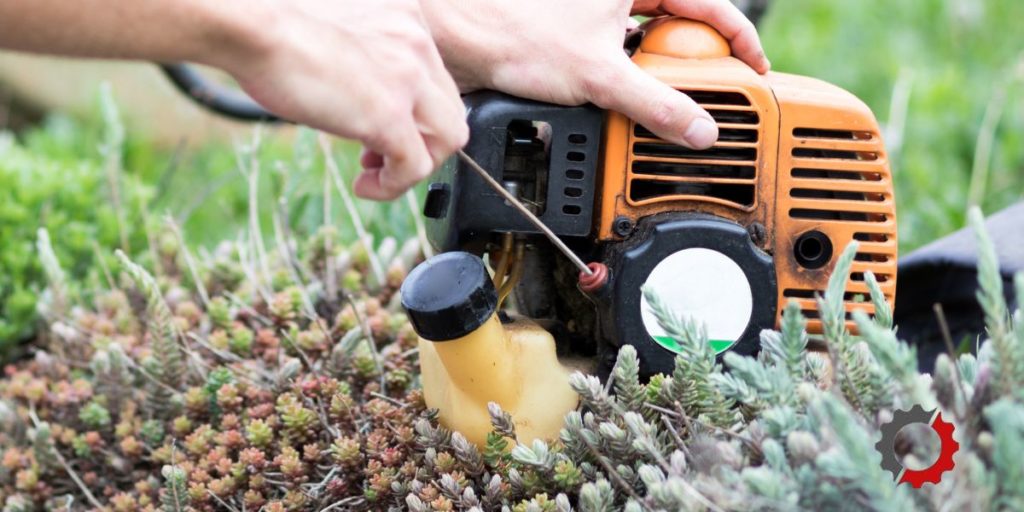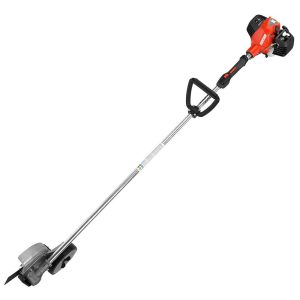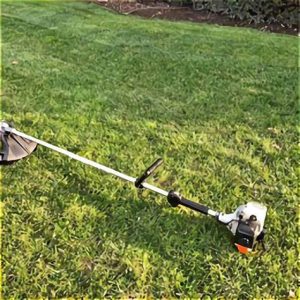13 Reasons Your Whipper Snipper Won’t Start
You regularly mow your lawn to keep your home’s appearance looking its best. It just doesn’t have a finished look until you use your whipper snipper. When a whipper snipper quits working, there are several things that can keep it from starting and running.
A whipper snipper won’t start when it isn’t getting sufficient air, fuel, or spark. This can be due to a plugged air filter, clogged fuel line, plugged fuel filter, faulty fuel tank vent, dirty carburetor, old fuel, plugged spark arrestor, or bad spark plug.
Keep reading for more items that can affect starting of a whipper snipper. Before performing any repairs, remove the spark plug wire, wait for the engine to cool, and wait for all moving parts to stop.

This post may include affiliate links. Purchases made through these links may provide a commission for us, at no extra cost to you. As an Amazon Associate, we earn from qualifying purchases.
Follow all safety instructions provided in your equipment operator’s manual prior to diagnosing, repairing, or operating.Consult a professional if you don’t have the skills, or knowledge or are not in the condition to perform the repair safely.
Table of Contents
Reasons Your Whipper Snipper Will Not Start
It’s best to start troubleshooting your whipper snipper by first checking the maintenance parts to make sure they are in good condition. This includes the spark plug, air filter, and fuel filter.
I like to replace these items before moving on to checking the other components on the whipper snipper that may cause a starting issue.
Plugged Air Filter in a Whipper Snipper
The air filter is an important item to have installed on your whipper snipper. The filter prevents dirt and air from getting sucked into the engine causing wear and damage.
When the filter isn’t cleaned or replaced regularly there can be so much buildup of dirt and debris that sufficient air isn’t able to pass through the filter. A lack of air means your whipper snipper will fail to start, run sluggishly or die.
A plugged air filter must be removed and replaced with a new air filter. It may be tempting to remove the filter and use your whipper snipper to finish up a job.
Doing so may help you get the job done, but it will also compromise the engine subjecting it to potential engine damage.
To avoid plugging the air filter, replace it annually. Check and clean it frequently throughout the season.
Solution: Close the choke to prevent dirt from falling into the carburetor throat. Remove the filter cover and filter. Wipe out any remaining dirt from the air filter housing. Replace a dirty air filter with a new air filter.
Bad Spark Plug in a Whipper Snipper
A dirty or damaged spark plug can cause intermittent spark problems that may prevent starting your whipper snipper. Inspect the spark plug for a dirty tip, burnt electrode, or cracked porcelain.
Check the spark plug gap to ensure it matches the manufacturer’s specifications.
Solution: I prefer to replace the spark plug, but if your plug is in good condition and just a little dirty you can clean it with a wire brush to reuse it. If the tip is very dark in color I recommend you just replace it with a new one. Attach the spark plug wire once you have completed your repairs.
Plugged Fuel Filter in a Whipper Snipper
The fuel filter keeps dirt that may have contaminated the fuel from passing into the fuel lines and carburetor. You will find the fuel filter located inside the fuel tank.
When the filter isn’t changed out regularly, it can become plugged and not allow sufficient fuel to flow through the filter. When the engine isn’t getting enough fuel, it will fail to start.
Solution: Locate the fuel filter in the fuel tank. Remove an old dirty filter from the fuel line and replace it with a new fuel filter. Be careful when changing out the filter.
There is a small ring clip that holds the fuel line to the filter for some whipper snippers. Don’t lose this ring and make sure it is securely in place holding the fuel line to the new fuel filter.
Incorrect 2-Cycle Oil Mix in a 2-Cycle Whipper Snipper
Using only petrol in a 2-cycle whipper snipper will damage the engine and cause it to seize up. Adding straight petrol to your whipper snipper is a quick way to ruin it.
The 2-cycle engine in a whipper snipper uses a petrol and oil mixture at a ratio of 50:1, 40:1, or 32:1 depending on the brand and model. For example, a 50:1 mixture equals 50 parts petrol to 1 part 2-cycle oil.
You can find the correct mix ratio for your model listed in the operator’s manual. You may also find it on the original fuel cap.
When creating this mix, use unleaded petrol with a minimum 95 RON and maximum ethanol content of 10%. Add a 2-cycle premium oil that is ISO-L-EGD and JASO M345 FD certified.
Mix it in an approved petrol can before adding it to your fuel tank.
Solution: Drain the fuel tank and fill it with the correct petrol-to-oil mix. If you continue to have problems, have a small engine mechanic diagnose the problem and determine whether a cost-effective repair can be made.
2-Cycle Premixed Fuel
A great option to reduce fuel problems and extend engine life is using an ethanol-free fuel mix. Many manufacturers offer their own brand of premixed fuels.
This is an ethanol-free blend of oil and fuel that is ready to pour into your whipper snipper’s fuel tank.
You won’t have to deal with the bad effects of ethanol as discussed in the fuel section. Also, it’s convenient to have fuel available on your shelf when you need it.
2-Cycle Whipper Snipper Petrol to Oil Mix Ratio
| Mixture | 5 Litre Petrol | 10 Litre Petrol |
|---|---|---|
| 50:1 | 100 ml oil | 200 ml oil |
| 40:1 | 125 ml oil | 250 ml oil |
| 32.1 | 156.25 ml oil | 312.50 ml oil |
2-Cycle Whipper Snipper Manufacturer & Fuel Mix
| Manufacture | 2-Cycle Petrol to Oil Mix Ratio | 2-Cycle Oil | Premixed Fuel |
|---|---|---|---|
| ECHO | 50:1 | Echo | Red Armor Pre-Mix |
| Husqvarna | 50:1 | Husqvarna | XP Pre-Mix |
| MTD | 40:1 | ||
| Poulan Pro | 40:1 | ||
| RedMax | 50:1 | RedMax | |
| Ryobi | 50:1 | Ryobi | |
| Shindaiwa | 50:1 | Shindaiwa | Red Armor Pre-Mix |
| Stihl | 50:1 | Stihl | Moto Mix Pre-Mix |
| Troy-Bilt | 40:1 | ||
| Yard-Man | 40:1 |
Incorrect or Insufficient Engine Oil in a 4-Cycle Whipper Snipper
4-cycle engines have separate fill ports for the engine oil and the fuel. DO NOT mix the oil and fuel together if you own this type of engine. Never use 2-cycle oil in a 4-cycle whipper snipper.
Oil is required to keep the engine components lubricated. When the wrong type or not enough oil is used, friction can build in the engine and overheat causing your whipper snipper not to start and possibly ruin the engine.
Solution: Drain the engine oil and fill it with the correct oil grade. When running your whipper snipper in very cold or very hot temperatures, you may have to adjust the viscosity to your ambient temperature.
If you continue to have problems, have a small engine mechanic diagnose the problem and determine whether a cost-effective repair can be made.
4-Cycle Whipper Snipper Manufacture and Engine Oil Viscosity
| Manufacturer | Engine Oil |
|---|---|
| Craftsman | SAE30 |
| Honda | 10W-30 |
| Husqvarna | 10W-40 |
| Makita | 10W-30 |
| Ryobi | 20W-50 (Recommended), SAE30, 10W-30, 10W-40 |
| Troy-Bilt | SAE30 |
Old Fuel in a Whipper Snipper
Old fuel left in a whipper snipper won’t only cause fuel restrictions, but it can also damage the carburetor and engine. Petrol can begin to break down as quickly as 30 days after purchase.
The ethanol found in most petrol attracts moisture from the air. This moisture and ethanol mixture gums up the fuel system and components.
Because petrol can begin to break down quickly, it needs to be consumed quickly. If you are unable to use it before it begins to break down, add a fuel additive to stabilize the fuel so it lasts a little longer.
Always use unleaded petrol with a minimum 95 RON and a maximum ethanol content of 10% (E10). Never use E15 or E85 in the engine as this will damage the engine and most likely void manufacturer warranties.
Solution: Drain any old fuel remaining in your whipper snipper and fill it with fresh fuel. This is an oil and fuel mix for a 2-cycle engine and unleaded petrol for a 4-cycle engine.
Add a fuel additive like STA-BIL to stabilize the fuel, clean the fuel system and reduce moisture in the fuel.
Bad Primer Bulb on a Whipper Snipper
A cracked primer bulb that won’t fill up with fuel won’t function correctly to get fuel to the carburetor for starting the whipper snipper.
Solution: Replace with a new primer bulb.
Fuel Line Blocked on a Whipper Snipper
Old fuel sitting in your whipper snipper can leave a gummy sticky deposit behind that restricts fuel flow. This can clog the fuel line and restrict the fuel flow your unit requires to start.
Solution: Replace a fuel line in the whipper snipper when it is cracked, kinked, or clogged.
Plugged Fuel Tank Vent on a Whipper Snipper
The fuel tank vent allows air into the tank. Without a vent, the fuel tank will create a vacuum that won’t allow fuel to flow through the whipper snipper.
A good indication you may have a fuel tank vent problem is when your whipper snipper runs for a few minutes and then shuts down and won’t start until you remove the fuel cap to allow air into the fuel tank. It then shuts down again after running for several minutes with the fuel cap in place.
Solution: Replace the fuel tank vent so the air can flow into the fuel tank. The vent may be attached to a line coming out of the tank. The fuel tank may vent through the fuel cap. This varies by manufacturer and model.
Clogged & Dirty Carburetor on a Whipper Snipper
The carburetor regulates the amount of fuel that is mixed with air to create a combustion in the cylinder. Old fuel will gum up and clog the carburetor so it no longer functions properly.
Solution: If you are a little mechanical you should be able to handle cleaning your carburetor. Clean the carburetor by taking it apart and using carburetor cleaner to clean it.
If the carburetor does not function after being cleaned, you may need to rebuild it or replace it with a new carburetor.
Depending on the model you run, the age of the unit, and the price of the carburetor, it may be best to invest in a new whipper snipper rather than put money towards replacing a carburetor on an old whipper snipper.
Bad Recoil Starter on a Whipper Snipper
Your whipper snipper uses a recoil to start the engine. A bad pulley; loose or missing spring; or broken clips can keep your recoil from working.
Solution: You can attempt to replace the spring and restring the recoil. If it does not work because other components in your recoil are damaged, such as the clips or the pulley, you are better off just replacing the recoil assembly.
Bad Spark Arrestor in a Whipper Snipper
You will find a spark arrestor in your whipper snipper that can prevent it from starting. The spark arrestor is a small screen that can get plugged with soot.
Solution: Disconnect the spark plug boot. Remove the engine cover and engine exhaust cover. Remove the spark arrestor and clean it with a wire brush to remove the soot.
If you are unable to clean it sufficiently or it is broken or has a hole in it, replace it with a new spark arrestor. Reinstall the screen and reattach the exhaust and engine covers. Reconnect the spark plug boot if you have finished your repairs.
Flooded Whipper Snipper
I have had customers bring their whipper snipper to the repair shop because they can’t get it started. Many times it’s due to a flooded engine which isn’t too serious.
The engine can become flooded when the choke is in the closed position and the starter rope was pulled many times allowing too much petrol to the carburetor.
It can also happen with the switch off and the starter rope being pulled multiple times or when the primer bulb is pushed too many times.
Solution: Use the following procedure to “unflood” your whipper snipper so the engine gets the correct fuel-to-air ratio required to start and run.
How to Fix a Flooded Engine on a Whipper Snipper
- Turn the switch on to the run position.
- Move the choke lever to the run position.
- Press the throttle trigger while pulling the starter rope over and over. This can take anywhere between 5 and 15 pulls before it starts. Your whipper snipper engine will sputter first. Continue to pull a few more times and it should start.







